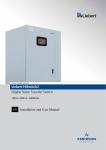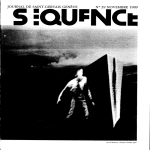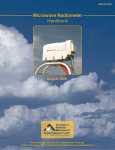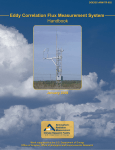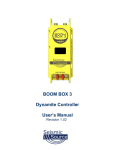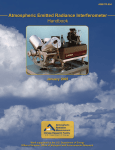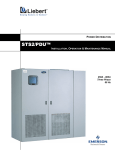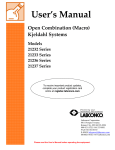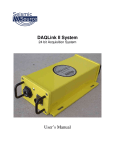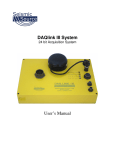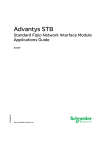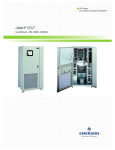Download (BLC) Handbook
Transcript
ARM TR-040 Belfort Laser Ceilometer (BLC) Handbook January 2005 C. Flynn Work supported by the U.S. Department of Energy, Office of Science, Office of Biological and Environmental Research January 2005, ARM TR-040 Contents 1. 2. 3. 4. 5. 6. 7. General Overview ............................................................................................................................... 1 Contacts............................................................................................................................................... 1 Deployment Locations and History..................................................................................................... 1 Near-Real-Time Data Plots ................................................................................................................. 1 Data Description and Examples .......................................................................................................... 2 Data Quality ........................................................................................................................................ 4 Instrument Details ............................................................................................................................... 8 Figures Figure 1. ........................................................................................................................................................ 2 iii January 2005, ARM TR-040 1. General Overview Note: This instrument was replaced by a Vaisala 25k Ceilometer in the summer of 2000. The Belfort laser ceilometer (BLC) Model 7013C field unit is a self-contained, ground-based, optical, active remote sensing instrument with the ability to detect and process several cloud-related parameters. These parameters include cloud height, extinction coefficient, cloud layers, and time/date reference information. The ceilometer system detects clouds by transmitting pulses of infrared light vertically into the atmosphere. The receiver telescope detects scattered light from clouds and precipitation. 2. Contacts 2.1 Mentor Connor J. Flynn Senior Staff Scientist Pacific Northwest National Laboratory P.O. Box 999, MS K9-27 Richland, WA 99352 Phone: 509-375-2041 Fax: 505-372-6978 [email protected] 2.2 Instrument Developer Belfort Instruments Baltimore, Maryland 3. Deployment Locations and History Only one BLC has been purchased for the ARM program. It was operational up to mid-day March 24, 2000. The instrument was then removed and sent for repair. The decision was made not to repair the BLC; it was replaced by a Vaisala 25K ceilometer (VCEIL). 4. Near-Real-Time Data Plots This section does not apply to this instrument because it was retried. 1 January 2005, ARM TR-040 5. Data Description and Examples Data from: 9/6/93 Figure 1. • • • • • 5.1 09/07/93 09/24/93 10/17/93 10/28/93 11/11/93. Data File Contents 5.1.1 Primary Variables and Expected Uncertainty The BLC measures the following quantities between the heights of 15 and 7350 m directly above ground level: • • • base height of lowest cloud detected base height of second-lowest cloud detected base height of third-lowest cloud detected. The base height of the second- and third-lowest clouds are not always reported because they can be optically obscured by the lower clouds. In addition, visibility is reported and could be considered a secondary variable measured. The values for visibility are a qualitative indication of vertical visibility. A precise interpretation is difficult, because algorithm details have not been provided by the manufacturer. 2 January 2005, ARM TR-040 Also, backscattering profiles are available as a measured quantity. However, the files that contain these data in the Atmospheric Radiation Measurement (ARM) Program archive are separate and contain the letters (prof) for profile in the file name. 5.1.1.1 Definition of Uncertainty The ceilometer can detect up to three cloud layers at a time depending upon whether its beam is able to penetrate the previous layers and whether the backscattering is able to penetrate back through the lower layers and reach the detector. Because of this, the first layer indicated is usually the most accurate of the representations. Detection of multiple cloud layers may also be indicative of a broken or scattered lower deck, with detection of an upper cloud layer through gaps or holes in the lower cloud deck. However, because the ceilometer only actively collects backscattered photons for about 5 seconds of every 30-second measurement period, isolated clouds may be missed by the instrument. The intensity of backscattered light will be dependent on the density of clouds, rain, snow, or fog. The size of water droplets in the atmosphere will also affect the return signals. Additionally, the intensity of the return signal follows the inverse-square law. Therefore, in harsh sky conditions, the higher the clouds are in the sky, the higher the chance the clouds could be missed by the ceilometer. Users of the data should be aware of these factors and that the ceilometer has, at times, indicated clear skies when in fact there were clouds present. Site operators said that when the cloud cover became denser, the ceilometer resumed indicating cloud presence. The sky conditions that increase the probability that the reported cloud information could be inaccurate are described below: • • • very thin clouds in the presence of sunlight scattered or broken cloud layers harsh sky conditions such as heavy fog, rain, or other precipitation, which blind the detector. A comparison was performed between a Vaisala 25K ceilometer over a 20-day period from 15 September to 5 October 1997. There were enough clouds within a 9-day period to be able to compare cloud heights. The comparison was complicated by the fact that there was about a 5-hour time offset in the VCEIL data and the BLC data were contaminated by cloud-height values above 100,000 m. After windowing the data to remove the time offset and ignoring the spurious BLC cloud heights, the two measurements compared well, with both measurements showing the same general shape and the BLC showing clouds heights 100 to 120 m higher than the VCEIL. 5.1.2 Secondary/Underlying Variables This section is not applicable to this instrument. 5.1.3 Diagnostic Variables This section is not applicable to this instrument. 3 January 2005, ARM TR-040 5.1.4 Data Quality Flags There are a couple different sets of flags that are set for the data. If the data is missing for a sample time, a “missing_value” value of -999 is assigned to that field. Secondly, an “operational_state” field flags the operational state of the instrument. If the value of this field is 0, then the instrument is operating normally. Other flags are as follows: • • • • status_0x1000 = BLC Maintenance - data may not be representative of environment status_0x2000 = Comm Status - data not available status_0x4000 = Packet Error - some data may be erroneous status_0x8000 = Data missing due to garbled data packet. (Note that this field is a floating point number, but really represents a bit-packed field. So, for example, 0x1000 shows up as “256.0”). 5.1.5 Dimension Variables This section is not applicable to this instrument. 5.2 Annotated Examples This section is not applicable to this instrument. 5.3 User Notes and Known Problems This section is not applicable to this instrument. 5.4 Frequently Asked Questions Is an evaluation of the performance of the BLC available? If so, how can I obtain this information? A cloud base height comparison was done between the BLC data, observations logged at the site, balloonborne sounding system (BBSS) data, and the Ponca City Airport’s Automatic Surface Observing System (ASOS) data. The comparisons took place from 8/18/93 through 11/17/93. An excel file will be available shortly for downloading. The BLC seems to be dependent on factory calibrations and initial settings. Are checks conducted in the field to make sure that the BLC is operating correctly? A “status_flags” field passes along the diagnostic flags from the data packet. A diagnostic command called “STAT” may be executed using software that came with the ceilometer to report the status of its flags. >STAT 4 January 2005, ARM TR-040 System status Irradiance Constant DSP_status TX_status TX_RAM_status TX_ROM_status TX_TMPLD_status TX_EEPROM_status TX_DPSUC_status TX_LDPSC_status TX_PELTC_status +/- 5V supply +/- 15V supply RX detector volts Temperature Sensor MDS Anode reading Laser Eye safety Heaters are The flags associated with the “STAT” command are described below: • System status - This flag reports the overall status of the ceilometer. This flag is updated after each data acquisition cycle. If any of the individual status flags listed below are ‘F’, then this flag will be ‘SICK’; otherwise the flag will be ‘HEALTHY.’ • DSP_status - This flag reports the overall status of the Digital Signal Processor (DSP) Printed Circuit Board (PCB). This flag is only set after a reboot of the ceilometer. The flag is ‘P’ if all the selftests that are performed on bootup are successful; otherwise, the flag is ‘F.’ • TX_status - This flag reports the overall status of the Transmitter PCB. If any of the individual flags associated with the Transmitter PCB are ‘F’, then this flag will also be ‘F.’ • TX_RAM_status - This flag reports the status of the internal RAM of the transmitter CPU (U32) and the external RAM chip (U29) on the transmitter PCB. This flag is determined only once, which is after a reboot of the Transmitter PCB. The flag is ‘P’ if reading from the RAM and writing to the RAM is successful; otherwise, the flag is ‘F.’ • TX_ROM_status - This flag reports the status of the EPROM chip (U28) on the transmitter PCB. This flag is determined only once, which is after a reboot of the transmitter PCB. The flag is ‘P’ if the EPROM has 00h as the least significant byte of the checksum; otherwise, the flag is ‘F.’ • TX_TMPLD_status - This flag reports the target vs. actual laser diode temperature status. This flag is updated after each data acquisition cycle. If | target - actual | < or = ‘TMPLD_FAIL’, then this flag is ‘P’; otherwise, the flag is ‘F’. The units for ‘TMPLD_FAIL’ are degrees Celsius, where 2 < or = ‘TMPLD_FAIL’ < or = 5. 5 January 2005, ARM TR-040 • TX_EEPROM_status - This flag reports the status of the EEPROM chip on the transmitter PCB. This flag is determined only once, which is after a reboot of the transmitter PCB. The flag is ‘P’ if each parameter stored in EEPROM and used by the transmitter PCB is within acceptable limits; otherwise, the flag is ‘F’. If the flag is ‘F’, then the data has been corrupted and must be reentered by using the transmitter PCB command “T1.” • TX_DPSUC_status - This flag reports the status of the Avalanche Photo-Diode (APD) power supply on the transmitter PCB. This flag is updated after each data acquisition cycle. The flag is ‘P’ if |target - actual | < or = 30 V; otherwise, the flag is ‘F.’ • TX_LDPSC_status - This flag reports the status of the laser diode power supply on the transmitter PCB. This flag is updated after each data acquisition cycle. The flag is ‘P’ if | target actual | < or = 20 V; otherwise, the flag is ‘F.’ • TX_PELTC_status - This flag reports the status of the Peltier Power Supply on the transmitter PCB. This flag is determined only once, which is after a reboot of the transmitter PCB. The flag is ‘P’ if the proper analog monitor signal is detected after momentarily setting the Peltier current to 5 A. • +/- 5V supply - This flag reports the status of the +5 V and -5 V outputs of the DC power supply. This flag is updated after each data acquisition cycle. The flag is ‘P’ if both of these outputs are within +/- 10% tolerance; otherwise, the flag is ‘F.’ • +/- 15 V supply - This flag reports the status of the +15 V and -15 V outputs of the DC power supply. This flag is updated after each data acquisition cycle. The flag is ‘PASS’ if both of these outputs are within +/- 10% tolerance; otherwise, the flag is ‘FAIL.’ • RX detector volts - This flag reports the status of the APD Power Supply on the transmitter PCB. This flag is updated after each data acquisition cycle. The flag is ‘P’ if the target and actual APD supply voltage are within 10% of each other; otherwise, the flag is ‘F’. This flag and ‘TX_DPSUC_status’ are essentially identical. • Temperature Sensor - This flag reports the status of the internal ambient temperature of the ceilometer. This flag is updated after each data acquisition cycle. The flag is ‘P’ if the ambient temperature inside the ceilometer is between -20 and +70°Celsius; otherwise, the flag is ‘F.’ • Meta data system (MDS) Anode reading - This flag reports the status of the test target infrared light-emitting diode (LED). This flag is updated after each data acquisition cycle. The flag is ‘P’ if the analog monitor signal at the anode of the test target LED is the expected voltage (~ 0.9091 V); otherwise, the flag is ‘F.’ • Laser eye safety - This flag reports the status of the fiber-optic cable in the transmitter telescope. This flag is updated after each data acquisition cycle. The flag is ‘P’ if the laser energy detected during the last data acquisition cycle is greater than ‘TLE safety threshold’, which is set by the “CONFIGU” command. If the laser energy is less than ‘TLE safety threshold’, then the fiberoptic cable for the transmitter telescope is probably disconnected and the flag is ‘F.’ 6 January 2005, ARM TR-040 • Heaters are - This parameter indicates the present ON/OFF status of the heaters. This parameter is updated after each data acquisition cycle. There are other bookkeeping and instrument health fields that are not flags per se (receiver temperature and laser voltage, etc.). Is the operational state of the BLC routinely described in the data stream? Operational state of the BLC is a bit field packed into floating point numbers containing the following: • • • • • • • • • • • target laser diode temperature receiver temperature actual laser diode temperature ceilometer ambient temperature laser Energy laser volts diagnostic flags from data packet APD volts north latitude east longitude altitude. 6. Data Quality 6.1 Data Quality Health and Status The following links go to current data quality health and status results: • • DQ HandS (Data Quality Health and Status) NCVweb for interactive data plotting using. The tables and graphs shown contain the techniques used by ARM’s data quality analysts, instrument mentors, and site scientists to monitor and diagnose data quality. 6.2 Data Reviews by Instrument Mentor • • • • • • QC frequency: Once or twice a week QC delay: Three days behind the current day QC type: “Quick-view” plots Inputs: “Operational_state” variable in the netcdf file sgpblcC1.*.cdf; “status flags” variable in the netcdf file Outputs: Reference: None. 7 January 2005, ARM TR-040 Data QC procedures for this system are fairly mature. Instrument mentor Connor Flynn’s monitoring of the BLC data quality consists of viewing once or twice a week the daily and weekly “quick-view” plots provided on the Web site provided by Lawrence Livermore National Laboratory (LLNL). The plots are usually about three days behind the current day. He also uses the Pennsylvania State University (PSU) “Daily Data Products” Web site; he prefers the latter but they are generally a week behind the current date. Connor examines the “operational_state” variable in the netcdf file sgpblcC1.*.cdf to detect garbled data packets. This variable is not contained in the raw data coming directly from the BLC but is produced as a bit-packed field by the collection module running on the Southern Great Plains (SGP) site data system (SDS). Each bit indicates the status of a given condition. The bit-packed field will be zero unless some condition has caused the data to be suspect. If one excludes data with operational_state <> 0 from consideration, outliers are very rare. A “smarter” ingest would be able to identify garbled data packets and adjust, which is not difficult; Connor has post-processes limited chunks of data to recover almost all of the “garbled” data. The “status_flags” variable in the netcdf file is also very useful for tracking instrument health. It is a bitpacked field and it is generated by the instrument itself and should be considered for possible addition to an automated data quality routine, raising a flag for non-zero values. Besides these monitoring activities that follow established ARM access routes to the data, Connor also uses a separate instrument PC that is attached to the BLC at the SGP central facility when he is onsite. This BLC PC collects and displays a duplicate of the BLC data set. This PC has software operating on it that allows him to view the current status of the instrument in a real-time mode. This dedicated PC shows a much lower amount of garbled data than seen in the files from the SGP SDS. An ingest of this data set is nearly ready for implementation. Visual plots of the BLC backscatter profiles that will be produced should included in the quick-look plots of LLNL and PSU. Finally, Connor occasionally uses his account on r1.sgp.arm.gov to access BLC data prior to its ingest and delivery from the ARM experiment center. This type of access is infrequent and is usually done when the mentor sees something unusual from the BLC PC. 6.3 Data Assessments by Site Scientist/Data Quality Office All Data Quality Office and most Site Scientist techniques for checking have been incorporated within DQ HandS and can be viewed there. 6.4 Value-Added Procedures and Quality Measurement Experiments Many of the scientific needs of the ARM Program are met through the analysis and processing of existing data products into “value-added” products or VAPs. Despite extensive instrumentation deployed at the ARM sites, there will always be quantities of interest that are either impractical or impossible to measure directly or routinely. Physical models using ARM instrument data as inputs are implemented as VAPs and can help fill some of the unmet measurement needs of the program. Conversely, ARM produces some VAPs, not in order to fill unmet measurement needs, but to improve the quality of existing 8 January 2005, ARM TR-040 measurements. In addition, when more than one measurement is available, ARM also produces “best estimate” VAPs. A special class of VAP, called a Quality Measurement Experiment (QME), does not output geophysical parameters of scientific interest. Rather, a QME adds value to the input datastreams by providing for continuous assessment of the quality of the input data based on internal consistency checks, comparisons between independent similar measurements, or comparisons between measurement with modeled results, and so forth. For more information, see VAPs and QMEs web page. 7. Instrument Details 7.1 Detailed Description 7.1.1 List of Components The BLC field unit contains all the electronics necessary to collect and process information about cloud formations, height, and other conditions. The collected data is then processed and transmitted to the SDS. The BLC components include the following: • • • • • • • • • • Transmitter Telescope Optical Assemblies Heaters and Fans Receiver PCB PC104 I/O PCB Receiver Telescope DC Power Supply Transmitter PCB PC104 CPU PCB DSP PCB. The ceilometer system includes the field unit and primary display unit. 7.1.2 System Configuration and Measurement Methods See the ceilometer system and a block diagram of the BLC. Light pulses generated by a laser diode are in the near-infrared range. The ceilometer uses a fiber-optic cable to transfer the output of the Gallium Arsenide laser diode to the focal point of a Newtonian telescope. The light energy is projected upward by the mirror in the transmitter telescope. The receiver telescope is aligned with the transmitter telescope for detecting light backscattered from any object in the transmitted beam. The beam divergence of both telescopes is less than 3 milliradians. The amount and quality of returned light will depend on the density of clouds, rain, snow, or fog. The size of water droplets in the atmosphere will also affect the return signals. Each data acquisition cycle consists of 5120 pulses of the laser diode. Immediately following the first pulse, the receiver telescope begins detecting the light backscattered from the atmosphere. These pulses are 150 ns wide and occur at 1.024-millisecond intervals. The data acquisition cycle can be repeated at a user-selected rate, but the default rate is every 30 seconds. 9 January 2005, ARM TR-040 In the first 5.12 seconds of a 30-second cycle, it sends out 5120 pulses and detects the backscatter. From 5.12 seconds until 10-12 seconds, it does number crunching to filter out noise and determine cloud presence and then dumps out its data stream. From 13 seconds until the end of the 30-second cycle, it does nothing. The time stamp within the data stream reflects 2 seconds before the beginning of the firing of the pulses, hence, the beginning of the cycle. The return signal for each transmitted pulse is analyzed, and information is stored in range cells that represent 7.6-meter (25-foot) increments. When the pulses are completed, the information stored is further analyzed and converted to data for transfer. The two covers of the BLC protect the electronics from environmental conditions. The two telescopes are mounted on the back of the plate and aligned for maximum efficiency. A glass cover over the telescopes is slanted to allow rain and melted snow to run off. Any snow that falls on the telescopes is quickly melted by the internal heating system that sufficiently maintains the temperature inside the unit during cold weather. The transmitter telescope transmits a pulsed laser-beam vertically into the atmosphere. Under the direction of the PC104 CPU, the DSP PCB sends 5120 trigger pulses to the transmitter PCB so that a pulsed laser-beam is generated for each data acquisition cycle. The receiver telescope detects backscattered energy and converts it to digital data. This data is continuously processed by the DSP PCB in real time during the 5120 pulses. After each pulse fired, the data is stored in range cells according to the time received after the transmitted pulse. Upon completion of the 5120th pulse, the collected data is analyzed, processed, and transmitted to the SDS. Each data acquisition cycle consists of 5120 pulses of the laser diode. These pulses are 150 ns wide and occur at 1.024-millisecond intervals. Immediately following the first pulse, the receiver telescope begins detecting the light backscattered from the atmosphere. The data acquisition cycle can be repeated at a user-selected rate with the default stored in the system configuration of the ceilometer. Selectable rates range from 30 seconds up to 3600 seconds. The Data Acquisition Cycle During normal operation, the ceilometer performs a data acquisition cycle every 30 seconds. Each data acquisition cycle has a duration of 5.24 seconds and creates four data arrays in RAM on the DSP PCB. These four data arrays are the summations of data for Phase 0, Phase 1, Phase 2 and Phase 3. A data acquisition cycle consists of 5120 consecutive phase cycles, each of 1.024 millisecond in duration. During each phase cycle, the laser diode is pulsed for 150 ns in Phase 0. Then, in Phase 1, the input datacomparator is given a positive offset voltage of +6.2 mV. In Phase 2, the input data-comparator is given a negative offset voltage of -6.2 mV. Finally, in Phase 3, the data comparator is given no offset voltage. The purpose of Phase 1 and Phase 2 during each phase cycle is to convert the signal-to-noise (S/N) ratio of the received signal into a voltage. The four phases are described as follows: • Phase 0: Received echo from a fired laser. 10 January 2005, ARM TR-040 • Phase 1: Received background with +6.2 mV offset at the comparator in place of a laser echo signal. • Phase 2: Received background with -6.2 mV offset at the comparator in place of a laser echo signal. • Phase 3: Received background with no laser echo and no offset. During each of the four phases, 1024 bits of data (range cells) are collected at a 20-MHz rate and then added to the running sum (accumulated) for that particular phase. At the end of the entire data acquisition cycle, four 1024-by-16 arrays of accumulated data are stored in RAM on the DSP PCB. The 20-MHz sampling rate (50 ns) provides a height resolution of 7.6 m (25 ft). By sampling data at 50-ns intervals, the laser light has time to travel a total of 15 m (50 ft). These 15 m consists of 7.6 m up into the atmosphere and 7.6 m to return to the BLC. Optical System The transmitter optics and receiver optics are nearly identical. Each telescope consists of a concave mirror mounted at the bottom of the telescope tube. In the transmitter telescope, a fiber-optic cable conducts laser light from the laser diode down towards the transmitter mirror. In the receiver telescope, a fiber-optic cable conducts laser light from the receiver mirror up to the APD on the receiver PCB. Each telescope consists of a 21.6-cm-diameter tube case with a 20.3-cm-diameter concave mirror mounted in the bottom. At the top of the tube, a “spider” support-bracket is mounted to hold one end of each fiber-optic cable near the focal point of its associated mirror. The ends of the two fiber-optic cables are aligned for precise parallel collimation of the two telescopes. The other end of each fiber-optic cable is optically coupled to the transmitter optics assembly and receiver optics assembly. In the case of the transmitter laser diode, the light is focused into the fiber-optic cable for optimum transfer of energy into the telescope. The temperature of the transmitter laser diode is monitored, and a Peltier cooler is used to maintain a proper temperature range. If the laser diode temperature exceeds predetermined limits, voltage to the laser diode is temporarily reduced to 70 V, but is restored when the laser diode returns to an acceptable temperature. Another safety feature is the monitoring of the frequency and duration of the trigger pulses. If acceptable limits are exceeded during a data acquisition cycle, voltage to the laser diode is reduced to 0 V for the next data acquisition cycle. This feature protects the laser diode from damage and ensures compliance with eye-safety regulations. In the receiver telescope system, the light from the fiber-optic cable is focused into the APD. The receiver lens system has two lens with an infrared light filter located in between. The first lens is used to collimate the light into the filter. The filter rejects light wavelengths outside the desired range and passes the desired light into the second lens. The second lens focuses the received light into the APD. Using the filter increases the S/N ratio of the system by rejecting unwanted light wavelengths. The effects of sunlight and other sources of possible optical noises are reduced. 11 January 2005, ARM TR-040 Firmware Overview The entire operation of the BLC is controlled by a master microprocessor located on the PC104 CPU PCB. This microprocessor, also referred to as AM286LX-16 or PC104 CPU, executes the firmware programmed into the 512KB EPROM in socket S0. The PC104 CPU also uses the DR DOS 5.0 Operating System. The transmitter PCB has a microcontroller that acts as a slave to the PC104 CPU. This microcontroller, also referred to as 80C552 or transmitter CPU, executes the firmware programmed into the 64KB EPROM in U28. The PC104 CPU performs numerous software tasks and hardware control activities that enable the BLC to detect and process cloud-height information. One of these tasks is communicating with and controlling the transmitter CPU that, in turn, directly controls the hardware on the transmitter PCB. Laser firing, data-acquisition, digital-signal-processing, system diagnostics, and interfacing to an external user or system are just some of the other tasks performed by the PC104 CPU. The transmitter CPU acts as a slave to the PC104 CPU. Therefore, one of the primary tasks of the transmitter CPU is to communicate (via serial port COM3) with the PC104 CPU. Some of the other tasks performed by the transmitter CPU include controlling the supply voltages for the laser diode and APD, controlling the Peltier cooler, and performing transmitter PCB diagnostics. Processing Received Signals Stored data in the four arrays must be processed mathematically to determine what signal power actually entered the receiver telescope at each range cell (7.6 meter increment). The received power data is required for input to a Klett light detection and ranging (LIDAR) inversion program. The data for each phase array contains information to be used in processing the return signals. Signal plus noise data, noise data with offsets, and background data make it possible to extract the desired signal from the raw data. Coupled with gain control for altitude and established factors from calibration, the resulting information will indicate how much light was backscattered by aerosols over a range of 15 meters to 7350 meters of altitude. The phase zero array consists of returned signal plus noise plus some breakthrough. The multiplier breakthrough (contamination from the swept gain waveform) is identical in Phase 0 and Phase 3. Subtracting Phase 3 from Phase 0 would, therefore, remove the multiplier breakthrough. However, a direct “range cell for range cell” subtraction would cause noise level to double, reducing detectability. Because multiplier breakthrough is known to be a low-frequency effect, a filter is able to extract a good, low noise estimation of the true multiplier breakthrough. It is this curve that is subtracted from Phase 0 to remove the effect of multiplier breakthrough. An additional breakthrough signal occurs due to some electrical coupling of laser firing energy into the Receiver preamplifier. This breakthrough appears as ringing in the first few range cells of Phase 0. A ring calibration procedure takes advantage of the fact that the ringing signal is stable and virtually independent of detector gain. The ring signal data is recorded and stored in EPROM during calibration. During normal operation, the ring signal is removed 12 January 2005, ARM TR-040 by subtracting the stored data from present data. The array that results after subtracting the two breakthrough effects is called the signal count array. The difference between Phase 1 and Phase 2 data is used to determine a conversion factor from comparator crossing counts to actual signal volts input to the comparator. The conversion factor array contains the ratio of volts to counts for each range cell. The signal volts array is, therefore, produced by multiplying the signal counts array by the conversion factor array. The volt array is then followed by an adaptive window filter. The adaptive window filter applies an averaging window size based on a S/N ratio of range cells. Range cells with a sufficiently high S/N ratio get an averaging window size of one (no averaging). As S/N ratio decreases, averaging window size for associated range cells increases. Noise level for S/N ratio determination is obtained as a function of average conversion factor at high range and a swept gain attenuation function. The computed noise level for each range cell is stored in a noise level array for use by the adaptive window filter and the squelch. A squelch is applied to reject range cells having a S/N ratio, after adaptive window averaging, that is too low for use by the Klett program. From the receiver front end to the comparator, the received signal is multiplied by a swept gain function to increase the dynamic range of the receiver. The effect of the swept gain function must be inverted so that the level of signal input to the receiver may be determined. To accomplish this, the signal volt array is multiplied by the reciprocal of the true, compound, swept gain function array. The pre-swept gain volts array is the result. After swept gain inversion, two factors are applied to obtain the actual signal power that struck the receiver telescope mirror. One factor is the system gain factor, which is established during ceilometer calibration using a system gain evaluator. The other factor is in an optical crossover array, X(R), which gives the fraction of beam overlap between the transmitter telescope and the receiver telescope as a function of range. An array, P(R), is the result of application of these two factors. P(R) is the actual power of echo light hitting the Receiver Telescope as a function of range. Finally, a simple function converts P(R) to an array S(R) that is actually used as input to the Klett LIDAR inversion program. Siting Requirements The field unit should be located in an area where collection of weather information is desired or needed, and the ground beneath and surrounding it should be leveled. The primary display unit is placed in a location convenient for system operators. 13 January 2005, ARM TR-040 7.1.3 Specifications BLC specifications are as follows: 7.2 • • Dimensions: 152 H X 72.4 W X 65.4 D centimeters Weight: o Field Unit 56.5 kg (125 lbs) o Shipping 105 kg (230 lbs). • • • • • Supply voltage: 115VAC/60Hz (U.S. Model) Power Consumption: 930 W Total (800 W Heaters, 130 W Electronics) Height Range: 15 to 7350 meters Height Resolution: 7.6 meters Optical Source: Gallium Arsenide Laser-Diode: o Wavelength: 910 nm (near-infrared) o Peak Optical Output: 15 W (nominal) o Optical Pulse Length: 150 ns (nominal) o Optical Pulse Repetition Frequency: 976.6 Hz o Receiver Optical Detector: APD. • • • Extinction coefficient variation: +/- 3 dB Update Period: 30 seconds to 3600 seconds in 1-second increments Environmental: o Temperature Range (storage): -50 to 65°Celsius o Temperature Range (Operational): -30 to 40°Celsius o Relative Humidity: 0-100% o Wind Speed: Max operational 50 m/s, Max survival on concrete base 75 m/s. Theory of Operation LIDAR Operation The BLC uses light wavelengths in the near-infrared range to detect clouds and other weather conditions. The BLC transmits a series of light pulses into the atmosphere and detects, processes, and analyzes the returned signals backscattered by the atmosphere. This principle allows the distance to light-scattering aerosols, such as a cloud, to be determined. The LIDAR system is similar to Radar in that a pulse of energy is emitted and returned energy analyzed for elapsed time between emitted and received pulses. The major difference is the frequency of emitted energy. Radar uses high-range radio frequencies, which will reflect from any object that conducts electricity. The LIDAR system uses light energy in the near-infrared region. An additional factor is the effect of light scattering according to the type of reflecting object. 14 January 2005, ARM TR-040 Elapsed time between transmission of a light pulse and backscattered energy is used to establish the distance to the reflecting object. The collected data is accumulated and stored in increments representing 7.6 m and sent to the SDS. Cloud layers are indicated according to their height above the unit. 7.3 7.3.1 Calibration Theory Because the ARM program relies entirely on original factory calibration procedures for the BLC, which include proprietary information, a description of calibration theory is not available. As described later under “Frequently Asked Questions,” evaluation of the performance of the BLC is carried out primarily by comparison of cloud base height data with measurements made by other systems and by an on-line diagnostic procedure identified as “STAT.” 7.3.2 Procedures This section is not applicable to this instrument. 7.3.3 History The BLC is factory calibrated by the manufacturer whom, when any of the instrument boards are serviced, also does a recalibration. The command “STAT” will check the status of the instrument to determine if everything is in normal working mode (see “Belfort Model 7013C Laser Ceilometer: Operating and Maintenance Procedures” by T.J. Peters, May 1995, Pacific Northwest National Laboratory). The BLC has never been calibrated other than when originally purchased from the manufacturer. 7.4 7.4.1 Operation and Maintenance User Manual This section is not applicable to this instrument. 7.4.2 Routine and Corrective Maintenance Documentation This section is not applicable to this instrument. 7.4.3 Software Documentation This section is not applicable to this instrument. 15 January 2005, ARM TR-040 7.4.4 Additional Documentation A. Calibrations and Related Performance Checks: 1. What are factory-recommended calibration procedures? There are two calibration procedures used to verify and/or optimize performance of the BLC. These procedures are denoted “SGAINCAL” and “RINGCAL.” Both procedures are detailed in Appendix A of this document. Both procedures require the use of the Belfort-manufactured “System Gain Calibration Unit”, also called the “Dog House.” 2. What are the factory-recommended performance checks? All performance checks of this instrument are automatic. The “instrument health” data appears in the instrument output data files. 3. What are the mentor calibration procedures? Calibration procedures are detailed in Appendix A. 4. What are the mentor performance checks? If the ceilometer data are suspect, the instrument mentor (or site operator) checks the “instrument health” data in the output data files to diagnose a possible instrument malfunction. The “instrument health” data is of sufficient detail to pinpoint a failing or failed component or subsystem. 5. How are calibration and related performance checks documented? Cursory performance checks of BLC performance are documented in the SGP Site Operations Log by the Site Operators. To date, there have been no re-calibrations of the BLC because the “System Gain Calibration Unit” was never purchased by the ARM Program. a. Where are procedures documented? Performance checks of ceilometer operation as well as calibration procedures are documented in the Belfort Model 7013C Ceilometer Technical Manual. b. Have major changes to calibration procedures occurred? If so, for which components and when? To our knowledge, Belfort has not issued any calibration procedure changes since the instrument was purchased and installed in 1993. c. Are major changes to calibration procedures expected to occur? If so, for which components and when? No major changes to calibration procedures are anticipated. 6. Who implements (mentors) calibration and performance checks? a. Mentor: The mentor and/or site ops personnel implement instrument performance checks and instrument calibration. b. Factory: Presumably, the instrument must pass numerous performance checks before it is shipped from the factory. c. Site Ops: Site ops personnel will support the instrument mentor in instrument performance checks and calibration procedures. 16 January 2005, ARM TR-040 7. What is standard schedule of calibrations and checks? The BLC manufacturer recommends instrument calibrations be performed upon delivery of the instrument and every 6 months thereafter. 8. How are the calibration and check procedures initiated (queued)? a. b. c. d. Scheduled Calendar Event: no Work Order: no Data Inspection: no Instrument Failure: BLC performance checks are generally initiated upon observation (by site ops personnel) of instrument malfunction or a perceived degradation in instrument performance. 9. How long does it take to perform calibration and performance check procedures? Performance checks require 1 data cycle (every 30-60 seconds) BLC calibration is anticipated to require 4-8 hours. 10. Are any data affected or lost during calibration or performance check procedures? No data are lost during instrument performance checks because the performance data appear in each data packet. Because BLC calibration requires placement of the “System Gain Calibration Unit” over the top of the ceilometer, cloud base height data cannot be acquired during this procedure. 11. What are corrective procedures when calibrations and or performance checks fall behind schedule? No corrective procedures have been implemented. B. Calibration Data: 1. Where are calibration data documented? a. b. c. d. e. f. g. h. i. j. Site Data System: no Site Ops Data base - Hard Copy: no Site Ops Data base - Electronic Copy: no Instrument Mentor - Hard Copy: yes Instrument Mentor - Electronic Copy: no Data Logger: no netCDF file: no Special Archive Database: no Special Databases accessible via the WWW: no Other: In the BLC LIDAR unit (EEPROM), which is accessible by the portable display unit (laptop computer residing in the SGP Control Trailer). 2. Where are calibration coefficients and algorithms applied to convert data to geophysical units? Conversion of raw LIDAR data to cloud base height and visibility occurs in the BLC transmitter/receiver module. These data may be accessed via modem or local area network. 17 January 2005, ARM TR-040 C. Maintenance Procedures: 1. What are the factory-recommended maintenance procedures: (preventive and corrective)? The ceilometer transmitter and receiver windows should be cleaned at least every three weeks using Windex or Glass-Plus. 2. What are the mentor preventative and corrective maintenance procedures? There are no documented preventative maintenance procedures. Corrective maintenance is performed at the board level (i.e., by replacing the circuit board containing the defective component(s)). 3. How are maintenance procedures documented? a. Where are procedures documented? Maintenance procedures are documented in Section 5 of the Belfort Model 7013C Ceilometer Technical Manual. b. Have major changes to maintenance procedures occurred? If so, for which components and when? No significant changes have been made to instrument maintenance procedures since the BLC was purchased and delivered in 1993. c. Are major changes to maintenance procedures expected to occur? If so, for which components and when? No major changes to maintenance procedures are anticipated. 4. What is the procedure schedule? As needed. 5. How are the procedures initiated (queued)? a. b. c. d. Scheduled Calendar Event: no Work Order: no Data Inspection: no Instrument Failure: Instrument maintenance procedures are initiated either by instrument failure or by a perceived degradation in instrument performance. 6. How long does it take to perform maintenance procedure? Variable, 1-8 hours. 7. Are any data affected or lost during maintenance procedure? BLC data is unavailable during performance of maintenance procedures. 8. How are potential affects to data documented? The time period during which the instrument was shut down for maintenance will be documented in the Site Operations Log. 9. What are corrective procedures when maintenance falls behind schedule? The only regular, periodic maintenance required for the BLC is cleaning of the transmitter and receiver windows. If the windows are overly dirty, this will be noticed by one of the site ops and corrected on the spot. 10. Where is actual maintenance work documented? In the Site Operations Log. 18 January 2005, ARM TR-040 D. Data Integrity and Quality Inspections: 1. What nodes or activities along the data pipeline affect (or can potentially affect) the data stream? a. b. c. d. e. f. Controller Boxes: ? Microprocessors: no Data Logger: no Communication lines/links: yes Calibration Data files: no Ingest Modules: yes. 2. What are current difficulties? There are no current difficulties in ingesting or distributing the BLC data. 3. List and describe any standard or non-standard data inspections (active or planned) under each of the following categories: a. Data Existence check: This check is performed during and after ingest by the Experiment Center at PNNL. This check is also performed periodically by Dave Ghlan at the SGP site. b. Mentor QC checks (during ingest): This check is the responsibility of the instrument mentor but has not yet been implemented on a regular basis. c. Mentor QC checks (outside of ingest): no d. Within Platform Check: no e. Multiple Platform Check: no f. Other automated netCDF file checks: no g. Other analytic tools or algorithms: no. Does storage media exist on the instrument system to back up data and store it for delayed data ingest? Please identify media and the maximum period of time that the data can be backed up on the media: Data may be temporarily stored on the hard disk of the BLC Portable Display Unit located in the SGP Control Trailer. The maximum amount of data that can be backed up on this laptop computer is unknown. 7.5 Glossary Ceilometer - An instrument that detects cloud base height Field Unit - The ceilometer itself 7.6 Acronyms APD ASOS BBSS BLC CPU Avalanche Photo-Diode Automatic Surface Observing System Balloon-Borne Sonde System Belfort Laser Ceilometer Central Processing Unit 19 January 2005, ARM TR-040 DC DSP EPROM I/O LED LIDAR LLNL MDS PCB QC PSU QME RAM SDS SGP S/N VAP Direct Current Digital Signal Processor Electrically Programmable Read Only Memory Input/Output light-emitting diode Light Detection And Ranging Lawrence Livermore National Laboratory meta data system Printed Circuit Board quality control Pennsylvania State University Quality Measurement Experiment Random Access Memory Site Data System Southern Great Plains signal-to-noise ratio value-added product(s) Also see the ARM Acronyms and Abbreviations. 7.7 Citable References None 20

























